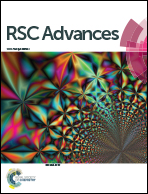Aggregation deaggregation influenced selective and sensitive detection of Cu2+ and ATP by histidine functionalized water-soluble fluorescent perylene diimide under physiological conditions and in living cells†
Abstract
Highly water-soluble fluorescent perylene diimide (PDI-HIS) functionalized with amino acid histidine is developed and utilized as a rapid “turn-off and turn-on” fluorescence and colorimetric probe for the detection of Cu2+ and ATP under physiological conditions and in A549 cells. The emission of PDI-HIS is completely quenched upon the formation of a Cu2+ complex, primarily caused by metal coordination induced molecular aggregation with a Ksv value of 7.1 × 106 M−1. The PDI-HIS + Cu2+ complex was highly selective for ATP due to the disaggregation of this complex with a very low limit of detection of 0.58 × 10−6 M. The low toxicity of the PDI-HIS probe allowed its use in the detection and imaging of both Cu2+ and ATP in A549 living cells. The formation of PDI-HIS + Cu2+ complex aggregates and their disaggregation with ATP was confirmed by the morphology changes as observed by AFM images and with dynamic light scattering (DLS) techniques, which strongly supported the aggregated form of the PDI-HIS + Cu2+ complex (∼120 nm diameter). The disaggregation of the PDI-HIS + Cu2+ complex with ATP was confirmed by AFM images and DLS techniques with the hydrodynamic particles diameter in the range of 200 ± 20 nm.


 Please wait while we load your content...
Please wait while we load your content...